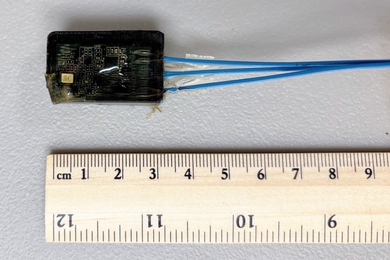The MIT Computer Science and Artificial Intelligence Laboratory (CSAIL) today inaugurated a new interdisciplinary center dedicated to developing the next generation of wireless networks and mobile devices. Headquartered at CSAIL and known as Wireless@MIT, the center will be a focal point for wireless research at MIT and will address some of the most important challenges facing the wireless and mobile-computing fields.
Wireless@MIT will involve more than 50 MIT faculty members, research staff and graduate students across different labs and academic departments, and will work with seven founding industry affiliates: Amazon, Cisco, Intel, MediaTek, Microsoft Research, STMicroelectronics and Telefonica.
“There are already over five billion mobile phones in the world today; add to this all the tablets, laptops, medical devices and wireless sensors, and the numbers are staggering,” says Hari Balakrishnan, the Fujitsu Professor in Electrical Engineering and Computer Science, who will serve as co-director of the center. “The goal of our center is to push the frontiers of wireless research to their full potential, and to ensure that the industry that grows up around these new devices is able to work in innovative and productive ways.”
The center’s work will focus on three key areas, the most important of which is the spectrum crisis: the exhaustion of radio spectrum caused by the explosive popularity of wireless systems. Wireless@MIT researchers aim to develop new techniques for overcoming this problem.
“By getting more from the spectrum that we already have, we can get 10 times higher data speeds for our wireless networks, and we can do it all without asking for additional spectrum,” says Dina Katabi, professor of computer science and engineering and the center’s other co-director.
Wireless@MIT’s second focus will be finding ways to reduce power consumption and extend battery life on mobile devices. The third is inventing new applications that gracefully accommodate mobility and network variability, ending the freezes, glitches and stalls that are common with today’s wireless networks. “The center aims to unleash a wide range of mobile uses that will change the way we live, work and entertain,” Katabi says.
Bringing together researchers and companies from across the wireless ecosystem is a distinctive feature of Wireless@MIT, and will enable a more holistic approach to mobile system design. Currently, companies involved in wireless — from application vendors and content providers to network operators, equipment manufacturers and radio chipset developers — operate more or less independently of each other.
“We believe that by communicating information between the different layers of wireless systems, we’ll see tremendous gains in performance, reliability and efficiency,” Balakrishnan says. “For instance, the videoconference application on your smartphone could do a much better job if it knew something about the underlying radio network and adapted to it.”
The center’s researchers are working on applying their wireless and mobile research to transportation, health care, education, collaboration and environmental sustainability. Projects already underway include safe and efficient road transportation, autonomous driving, wireless medical implants, mobile video delivery, multiparty wireless videoconferencing and energy harvesting.
One large-scale effort in the planning stages is a prototype wireless network being developed for the MIT campus. This prototype, which is envisioned to provide functional network service to users, will demonstrate cross-layer innovations in spectrum usage, mobile connectivity, reliability and security.
CSAIL, MIT’s largest interdepartmental laboratory, is well positioned to host the center. Currently in its 50th year, the lab has played a key role in the technology revolution of the past several decades. “The founding companies of the center represent key segments of the wireless industry,” says CSAIL Director Daniela Rus, professor of computer science and engineering. “We plan to work closely with their scientists to bring the best new research to light, and to make the center the go-to place for wireless research, at MIT and in the world.”
Wireless@MIT will involve more than 50 MIT faculty members, research staff and graduate students across different labs and academic departments, and will work with seven founding industry affiliates: Amazon, Cisco, Intel, MediaTek, Microsoft Research, STMicroelectronics and Telefonica.
“There are already over five billion mobile phones in the world today; add to this all the tablets, laptops, medical devices and wireless sensors, and the numbers are staggering,” says Hari Balakrishnan, the Fujitsu Professor in Electrical Engineering and Computer Science, who will serve as co-director of the center. “The goal of our center is to push the frontiers of wireless research to their full potential, and to ensure that the industry that grows up around these new devices is able to work in innovative and productive ways.”
The center’s work will focus on three key areas, the most important of which is the spectrum crisis: the exhaustion of radio spectrum caused by the explosive popularity of wireless systems. Wireless@MIT researchers aim to develop new techniques for overcoming this problem.
“By getting more from the spectrum that we already have, we can get 10 times higher data speeds for our wireless networks, and we can do it all without asking for additional spectrum,” says Dina Katabi, professor of computer science and engineering and the center’s other co-director.
Wireless@MIT’s second focus will be finding ways to reduce power consumption and extend battery life on mobile devices. The third is inventing new applications that gracefully accommodate mobility and network variability, ending the freezes, glitches and stalls that are common with today’s wireless networks. “The center aims to unleash a wide range of mobile uses that will change the way we live, work and entertain,” Katabi says.
Bringing together researchers and companies from across the wireless ecosystem is a distinctive feature of Wireless@MIT, and will enable a more holistic approach to mobile system design. Currently, companies involved in wireless — from application vendors and content providers to network operators, equipment manufacturers and radio chipset developers — operate more or less independently of each other.
“We believe that by communicating information between the different layers of wireless systems, we’ll see tremendous gains in performance, reliability and efficiency,” Balakrishnan says. “For instance, the videoconference application on your smartphone could do a much better job if it knew something about the underlying radio network and adapted to it.”
The center’s researchers are working on applying their wireless and mobile research to transportation, health care, education, collaboration and environmental sustainability. Projects already underway include safe and efficient road transportation, autonomous driving, wireless medical implants, mobile video delivery, multiparty wireless videoconferencing and energy harvesting.
One large-scale effort in the planning stages is a prototype wireless network being developed for the MIT campus. This prototype, which is envisioned to provide functional network service to users, will demonstrate cross-layer innovations in spectrum usage, mobile connectivity, reliability and security.
CSAIL, MIT’s largest interdepartmental laboratory, is well positioned to host the center. Currently in its 50th year, the lab has played a key role in the technology revolution of the past several decades. “The founding companies of the center represent key segments of the wireless industry,” says CSAIL Director Daniela Rus, professor of computer science and engineering. “We plan to work closely with their scientists to bring the best new research to light, and to make the center the go-to place for wireless research, at MIT and in the world.”







